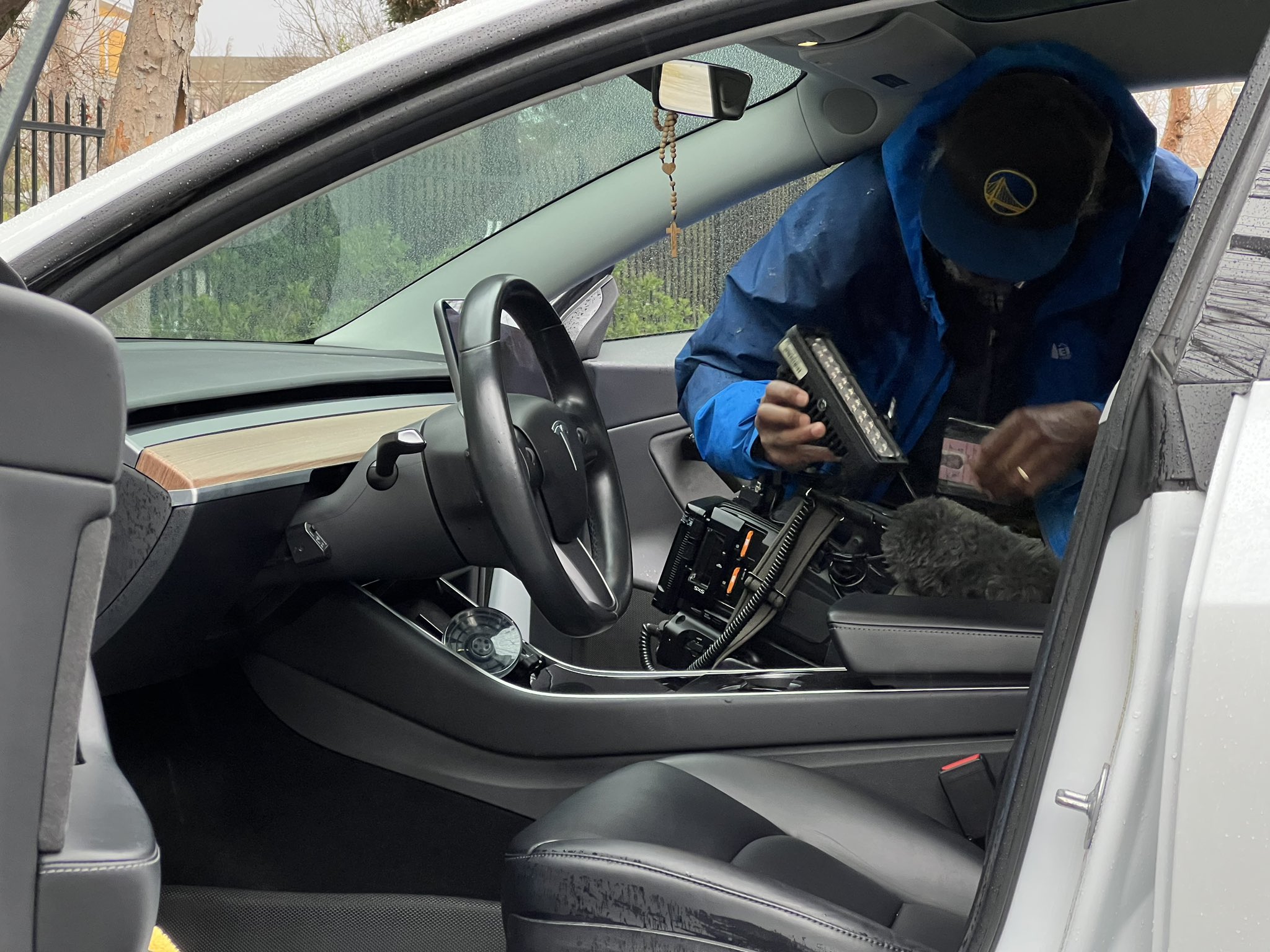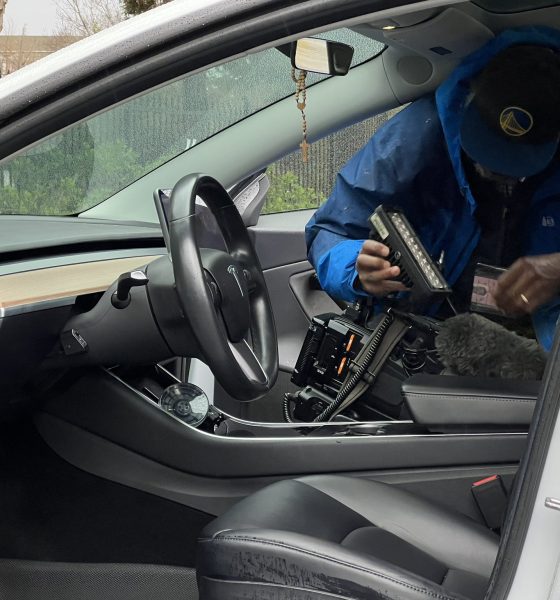

News
Tesla’s alleged Thanksgiving FSD crash in SF is being recreated by media
Tesla Owners Club of East Bay cofounder Wilmer Awayan teamed up with the local media to simulate an accident with Tesla’s Full Self-Driving Beta engaged. The club shared behind-the-scenes videos and photos on Twitter.
On Thanksgiving Day, the owner of a 2021 Tesla Model S claimed that his vehicle was operating with Tesla’s FSD Beta engaged and that the technology malfunctioned, causing an eight-car pile-up on San Francisco’s Bay Bridge.
The club tweeted that it had the unique opportunity to host an FSD Beta ride along with Brooks Jarosz with KTVU to simulate and re-enact what could have occurred in the accident. At this time, KTVU hasn’t published its story yet, but San Francisco has been dealing with a rainstorm that’s been keeping the local news crews pretty busy.
Al Shen, president of the club, told Teslarati that this was a great opportunity to share a first-hand look at Tesla’s FSD Beta technology.
FSD thru the same spot the accident occurred. Couldn’t get the original tweet to include this video. Camera crew was along for the ride. pic.twitter.com/ahWtNGmtVs
— Tesla East Bay Fremont (@TeslaOwnersEBay) January 13, 2023
In the video above, Shen shared footage of FSD Beta at the exact location of the accident, noting that the camera crew was along for the ride. Shen told Teslarati that he received an email from an investigative reporter from his local Fox News Station affiliate Channel 2.
“They were seeking a chance to re-enact and test out what FSD capability is and how it works on roads, particularly on the section of the SF Bay Bridge, one of the busiest bridges in America where that Tesla Driver caused that eight-car pile up on thanksgiving 2022,” he said.
Shen chose to help his local news station because he felt it was a unique opportunity to share a first-hand look at Tesla’s technology.
“As educated owners and a Tesla Owners enthusiast group here to support the brand’s mission, we felt it was a unique opportunity to give a first-hand look at what Tesla’s emerging autonomy and driver’s assist features for Full Self Driving look like from inside a Tesla as opposed to only reading about it or third-hand knowledge,” he said.
“We utilized FSD beta to navigate us to our rendezvous location and proceeded on the simulated drive across the SF-Oakland Bay bridge, even with inclement rain weather, the system performed nominally under rainy conditions although slower than some traffic.”
“As the FSD Beta vehicle approached the infamous tunnel where the Thanksgiving crash occurred, we proceeded through and even simulated a lane change similar to the one seen in the now-released traffic footage. Again we noticed a slight deceleration but nothing as extreme as what occurred in the accident.”
“FSD Beta offered some lane changes, which we declined to proceed with, the news team was impressed with the visualization and the car’s ability to visualize and process the world around it in real-time.”
“What we felt paramount to do, despite incurring a legitimate strike, was that our driver purposely disobeyed the software and did not confirm when warnings came to put our hands on the wheel and remain attentive at all times. The vehicle disengaged and began to slow down, however, given the open ‘testing’ environment we were in, we pressed the accelerator and resumed our drive at safer speeds and distances,” Shen added.
Update:
KTVU aired the video on this evening’s news.
Here’s the @KTVU evening news covering the simulated @Tesla FSD/AP drive we took @BrooksKTVU on this morning across the SF Bay Bridge to dive deeper into what sadly transpired on Thanksgiving 2022. 🔑: It’s on all of us as drivers to be attentive. pic.twitter.com/gwGnuVq7b6
— Tesla East Bay Fremont (@TeslaOwnersEBay) January 14, 2023
Disclosure: Johnna is a $TSLA shareholder and believes in Tesla’s mission.
Your feedback is welcome. If you have any comments or concerns or see a typo, you can email me at johnna@teslarati.com. You can also reach me on Twitter at @JohnnaCrider1.
Teslarati is now on TikTok. Follow us for interactive news & more. Teslarati is now on TikTok. Follow us for interactive news & more. You can also follow Teslarati on LinkedIn, Twitter, Instagram, and Facebook.

News
Tesla FSD fleet is nearing 7 billion total miles, including 2.5 billion city miles
As can be seen on Tesla’s official FSD webpage, vehicles equipped with the system have now navigated over 6.99 billion miles.

Tesla’s Full Self-Driving (Supervised) fleet is closing in on almost 7 billion total miles driven, as per data posted by the company on its official FSD webpage.
These figures hint at the massive scale of data fueling Tesla’s rapid FSD improvements, which have been quite notable as of late.
FSD mileage milestones
As can be seen on Tesla’s official FSD webpage, vehicles equipped with the system have now navigated over 6.99 billion miles. Tesla owner and avid FSD tester Whole Mars Catalog also shared a screenshot indicating that from the nearly 7 billion miles traveled by the FSD fleet, more than 2.5 billion miles were driven inside cities.
City miles are particularly valuable for complex urban scenarios like unprotected turns, pedestrian interactions, and traffic lights. This is also the difference-maker for FSD, as only complex solutions, such as Waymo’s self-driving taxis, operate similarly on inner-city streets. And even then, incidents such as the San Francisco blackouts have proven challenging for sensor-rich vehicles like Waymos.
Tesla’s data edge
Tesla has a number of advantages in the autonomous vehicle sector, one of which is the size of its fleet and the number of vehicles training FSD on real-world roads. Tesla’s nearly 7 billion FSD miles then allow the company to roll out updates that make its vehicles behave like they are being driven by experienced drivers, even if they are operating on their own.
So notable are Tesla’s improvements to FSD that NVIDIA Director of Robotics Jim Fan, after experiencing FSD v14, noted that the system is the first AI that passes what he described as a “Physical Turing Test.”
“Despite knowing exactly how robot learning works, I still find it magical watching the steering wheel turn by itself. First it feels surreal, next it becomes routine. Then, like the smartphone, taking it away actively hurts. This is how humanity gets rewired and glued to god-like technologies,” Fan wrote in a post on X.
News
Tesla starts showing how FSD will change lives in Europe
Local officials tested the system on narrow country roads and were impressed by FSD’s smooth, human-like driving, with some calling the service a game-changer for everyday life in areas that are far from urban centers.

Tesla has launched Europe’s first public shuttle service using Full Self-Driving (Supervised) in the rural Eifelkreis Bitburg-Prüm region of Germany, demonstrating how the technology can restore independence and mobility for people who struggle with limited transport options.
Local officials tested the system on narrow country roads and were impressed by FSD’s smooth, human-like driving, with some calling the service a game-changer for everyday life in areas that are far from urban centers.
Officials see real impact on rural residents
Arzfeld Mayor Johannes Kuhl and District Administrator Andreas Kruppert personally tested the Tesla shuttle service. This allowed them to see just how well FSD navigated winding lanes and rural roads confidently. Kruppert said, “Autonomous driving sounds like science fiction to many, but we simply see here that it works totally well in rural regions too.” Kuhl, for his part, also noted that FSD “feels like a very experienced driver.”
The pilot complements the area’s “Citizen Bus” program, which provides on-demand rides for elderly residents who can no longer drive themselves. Tesla Europe shared a video of a demonstration of the service, highlighting how FSD gives people their freedom back, even in places where public transport is not as prevalent.
What the Ministry for Economic Affairs and Transport says
Rhineland-Palatinate’s Minister Daniela Schmitt supported the project, praising the collaboration that made this “first of its kind in Europe” possible. As per the ministry, the rural rollout for the service shows FSD’s potential beyond major cities, and it delivers tangible benefits like grocery runs, doctor visits, and social connections for isolated residents.
“Reliable and flexible mobility is especially vital in rural areas. With the launch of a shuttle service using self-driving vehicles (FSD supervised) by Tesla in the Eifelkreis Bitburg-Prüm, an innovative pilot project is now getting underway that complements local community bus services. It is the first project of its kind in Europe.
“The result is a real gain for rural mobility: greater accessibility, more flexibility and tangible benefits for everyday life. A strong signal for innovation, cooperation and future-oriented mobility beyond urban centers,” the ministry wrote in a LinkedIn post.
News
Tesla China quietly posts Robotaxi-related job listing
Tesla China is currently seeking a Low Voltage Electrical Engineer to work on circuit board design for the company’s autonomous vehicles.

Tesla has posted a new job listing in Shanghai explicitly tied to its Robotaxi program, fueling speculation that the company is preparing to launch its dedicated autonomous ride-hailing service in China.
As noted in the listing, Tesla China is currently seeking a Low Voltage Electrical Engineer to work on circuit board design for the company’s autonomous vehicles.
Robotaxi-specific role
The listing, which was shared on social media platform X by industry watcher @tslaming, suggested that Tesla China is looking to fill the role urgently. The job listing itself specifically mentions that the person hired for the role will be working on the Low Voltage Hardware team, which would design the circuit boards that would serve as the nervous system of the Robotaxi.
Key tasks for the role, as indicated in the job listing, include collaboration with PCB layout, firmware, mechanical, program management, and validation teams, among other responsibilities. The role is based in Shanghai.
China Robotaxi launch
China represents a massive potential market for robotaxis, with its dense urban centers and supportive policies in select cities. Tesla has limited permission to roll out FSD in the country, though despite this, its vehicles have been hailed as among the best in the market when it comes to autonomous features. So far, at least, it appears that China supports Tesla’s FSD and Robotaxi rollout.
This was hinted at in November, when Tesla brought the Cybercab to the 8th China International Import Expo (CIIE) in Shanghai, marking the first time that the autonomous two-seater was brought to the Asia-Pacific region. The vehicle, despite not having a release date in China, received a significant amount of interest among the event’s attendees.








